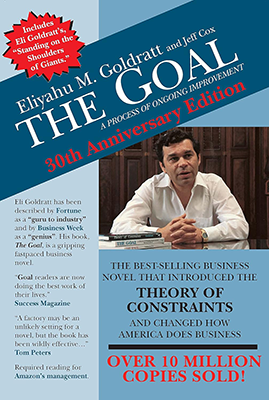The Goal
“The Goal: A Process of Ongoing Improvement” by Eliyahu M. Goldratt is a business novel that presents the Theory of Constraints (TOC), a management philosophy and methodology for improving operational efficiency and achieving business goals. Here’s a summary of its key points:
- Introduction to the Theory of Constraints: The book introduces the Theory of Constraints (TOC), which proposes that every system—whether it’s a manufacturing process, a supply chain, or a business organization—has one or more constraints that limit its ability to achieve its goals. The goal of TOC is to identify and address these constraints in order to improve overall performance.
- The Goal of a Business: Goldratt defines the goal of a business as making money, both in the short term and the long term. He emphasizes the importance of aligning all activities and decisions with this overarching goal, rather than focusing on individual metrics or objectives.
- Identifying Constraints: The book explores techniques for identifying constraints within a system, such as using the Five Focusing Steps of TOC: identify the constraint, exploit the constraint, subordinate everything else to the constraint, elevate the constraint, and repeat the process as constraints are resolved.
- Improving Throughput: Goldratt emphasizes the importance of maximizing throughput—the rate at which a system generates money through sales—in order to achieve the goal of making money. He discusses strategies for increasing throughput by optimizing the performance of the constraint and streamlining other activities to support it.
- Buffer Management: The book introduces the concept of buffer management, which involves strategically placing buffers of inventory or time at key points in a system to protect against disruptions and variability. Goldratt discusses how buffer management can help balance flow, reduce lead times, and improve reliability.
- Performance Metrics: Goldratt challenges traditional performance metrics such as cost accounting and efficiency, arguing that they often lead to suboptimal decision-making and behavior. He advocates for the use of more holistic metrics, such as throughput, inventory, and operational expense (TIO), to evaluate the overall performance of a system.
- Continuous Improvement: The book emphasizes the importance of continuous improvement and learning in achieving business success. Goldratt discusses the need for ongoing experimentation, innovation, and adaptation in order to stay competitive and address changing market conditions.
- Application Across Industries: Goldratt illustrates the principles of TOC through a fictional narrative set in a manufacturing plant, but he emphasizes that the concepts are applicable across a wide range of industries and organizational contexts. He encourages readers to apply the principles of TOC to their own businesses and processes to drive improvement and achieve their goals.
Overall, “The Goal” provides a practical and accessible introduction to the Theory of Constraints and its application in improving business performance. Whether you’re a business leader, manager, or aspiring entrepreneur, Goldratt’s insights can help you identify and address constraints in your own organization and drive meaningful improvement.

